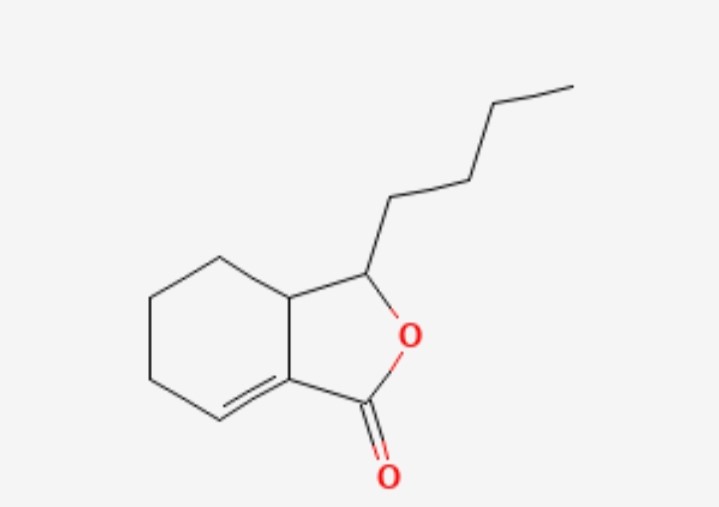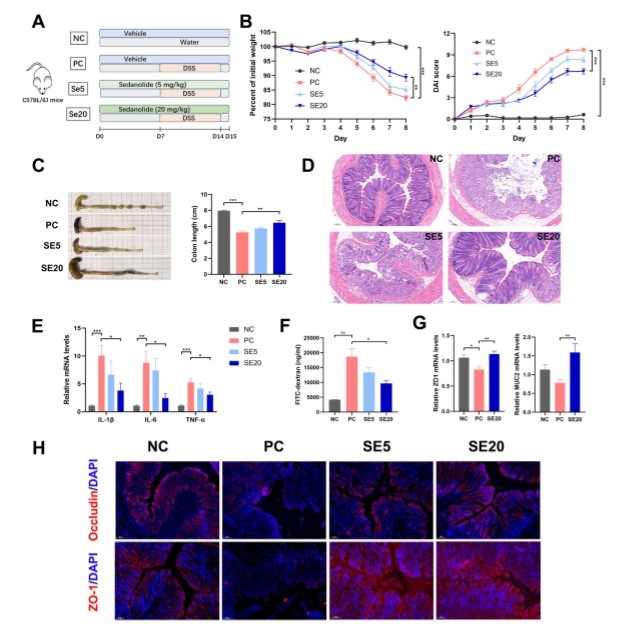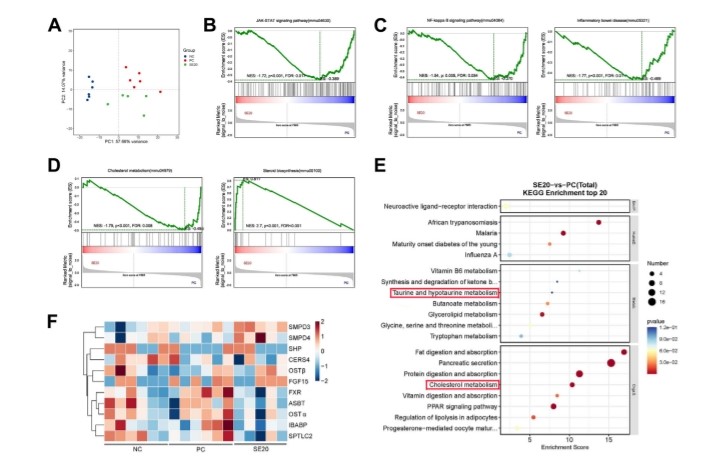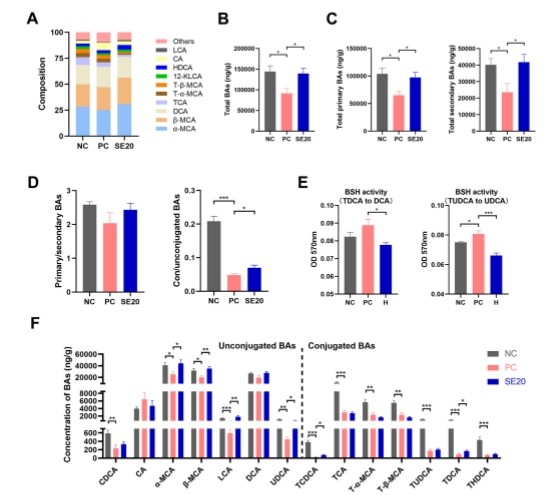Sedanolide
Naturally occurring phthalide-like compound derived from celery seed oil is the sedanolide( Glpbio) which has antifungal , mosquitocidal and anti nematodal properties . Sedanolide has been shown to exert antioxidant effects by increasing glutathione S-transferase (GST) activity and by inhibiting tumor incidence .Nuclear factor E2-related factor 2 (NRF2) pathway is activated by sedanolide to protect mice from acetaminophen-induced liver injury and it is also associated with bacteria such as Lactobacillus. Prebiotics such as polysaccharides, can interact with the gut microbiota and treat intestinal diseases such as colitis . Based upon the findings, researchers hypothesized that sedanolide could ameliorate oxidative stress and inflammatory diseases, through a mechanism that depends on the gut microbiota. But effects of sedanolide on inflammatory bowl disease are still nuclear.

Figure 1: shows the chemical structure of Sedanolide.
Sedanolide protects from DSS-induced colitis by attenuating intestinal inflammation and strengthening the gut barrier: For the evaluation of the impact of different concentrations of Sedanolide on DSS-induced colitis, mice were treated with 5 or 20 mg/kg sedanolide . During the experiment, DSS decreased the weight of the mice and increased the DAI score. However 20 mg/kg sedanolide (SE20) significantly increased body weight and decreased the DAI score and also increased colon length shortened by DSS in DSS-treated mice . By HE staining is was revealed that DSS led to severe inflammation, epithelial erosion and loss, crypt damage, and goblet cell loss, and all these effects were alleviated by sedanolide in a dose-dependent manner . Mice in the lower concentration group (SE5) experienced some protection compared to those in the SE20 group.It was also revealed by researchers that sedanolide restored intestinal permeability and strengthened the intestinal barrier in DSS-treated mice and the serum levels of FITC-dextran in the SE20 group were markedly lower than those in the PC group, and the changes in the mRNA expression of ZO-1 and MUC2 mRNAs were the same.

Figure 2: Shows that the Sedanolide alleviated DSS-induced colitis in mice. (A) Experimental scheme. (B) Percent of initial weight (left) and DAI score (right) of mice after DSS administration.(C) Representative photos of colon (left) and colon length (right) of mice.(D) Representative images of H&E staining of colon tissues . (F) The level of FITC-dextran in serum. (G) Relative expression of ZO-1 and MUC2) in colon tissues. (H) Representative images of immunofluorescence staining for Occludin and ZO-1 in colon tissues.
Sedanolide regulates multiple metabolic pathways this is revealed by transcriptome analysis :Transcriptome analysis was performed to explore the impacts of sedanolide on colitis at the transcriptional level and distinct clustering was observed among the NC, PC and SE20 groups. The GSEA results revealed that sedanolide significantly suppressed the Janus tyrosine kinase (JAK)- signal transducer and activator of transcription (STAT) signaling pathway in the presence of DSS . Sedanolide also suppressed the nuclear factor-kappa B (NF-kB) signaling pathway and genes associated with inflammatory bowel disease and marked differences were observed in cholesterol metabolism, steroid biosynthesis and taurine and hypotaurine metabolism, all of which are linked to bile acid metabolism . Therefore, researchers hypothesized that sedanolide could influence the metabolism of bile acids and they performed gene enrichment analysis of the genes associated with bile acid metabolism . As was predicted the results showed that the relative intensities of FXR,FGF15, ASBT, OSTa, IBABP and SPTLC2 in DSS-treated mice were decreased by sedanolide. SMPD3 and SMPD4 were upregulated by sedanolide that are the downstream genes of the FXR pathway.


Figure 3: Shows that the Sedanolide modulated multiple metabolic pathways in DSS-treated mice, especially the bile acid metabolism. (A) Principal component analysis (PCA) plot of transcriptome. (B-D) Enriched signaling pathway using GSEA. ( E ) Top 20 enriched pathway based on KEGG analysis. (F) Heatmap of FXR-related genes.
Sedanolide inhibits BSH activity and regulates bile acid metabolism : Targeted quantification of bile acids (Bas) in colonic contents was performed. The top 10 Bas are shown in Fig. 4A. BA concentrations were decreased by the administration of DSS and this effect was reversed by sedanolide and the same changes were seen in total primary BA concentrations levels and total secondary BA concentrations . In addition, there was a decrease in The ratio of primary Bas to secondary Bas after DSS treatment was decreased and sedanolide increased this ratio .DSS significantly reduced the ratio Conjugated Bas to unconjugated Bas ratio was significantly decreased by DSS and sedanolide resulted an increase in the ratio. DSS enhanced the ability of BSH to deconjugate TDCA and TUDC but it was reduced by sedanolide . In response to DSS treatment there was Significant decreases in the levels of CDCA, a-MCA, b-MCA, LCA, UDCA, TCDCA, TCA, T-a-MCA, T-b-MCA, TUDCA, TDCA and THDCA , while the levels of a-MCA, b-MCA, LCA, UDCA, TCDCA and TDCA were markedly increased by sedanolide . In short, sedanolide affects bile acid metabolism, subsequently inhibiting downstream FXR genes that are activated by DSS.

Figure 4 :shows that the sedanolide inhibited the BSH activity and regulated bile acid metabolism. (A) Composition of bile acids (B) Total bile acids in colonic contents. ( C ) Total primary bile acids (left) and total secondary bile acids (right) in colonic contents. (D) The ratio of primary/secondary bile acids (left) and the ratio of conjugated/unconjugated bile acids. ( E ) BSH activity of colonic contents. (F) Concentrations of bile acids profiles.
Sedanolide reshapes BA metabolism-related gut microbes: Bas and the gut microbiota have crosstalk between them. Therefore, researchers performed 16S rRNA sequencing and discovered that DSS administration markedly decreased a-diversity as shown by the Shannon index and Chao1 index. By Principal coordinate analysis (PCoA) it was know that the mice treated with sedanolide were distinctly clustered relative to mice with DSS-induced colitis. Researchers selected a portion of the main flora . After DSS challenge, at the phylum level the abundance of Firmicutes and Actinobacteriota decreased noticeably, and the abundance of Proteobacteria and Deferribacterota markedly increased. However, sedanolide noticeably reversed the changes in the abundances of Proteobacteria, Deferribacterota and Actinobacteriota. At the family level, by the DSS challenge the abundances of Muribaculaceae, Lachnospiraceae, Prevotellaceae and Ruminococcaceae decreased and increased the abundances of Enterobacteriaceae, Sutterellaceae and Erysipelotrichaceae. Sedanolide up-regulated the abundance of Prevotellaceae and down-regulated the abundances of Enterobacteriaceae, Sutterellaceae and Erysipelotrichaceae. At the genus level, by the DSS treatment the abundances of Escherichia-Shigella and Parabacteroides were markedly increased, and the abundances of Lachnoclostridium and Alloprevotalla were decreased . Sedanolide partially restored the abundances of Escherichia-Shigella, Lachnoclostridium and Parabacteroides. DSS administration increased the abundance of BSH-expressing bacteria especially Parabacteroides and Enterococcus, that can be decreased by sedanolide . Moreover,sedanolide also altered the levels of short-chain fatty acids (SCFAs).

Figure 5: Shows that Sedanolide reshaped the BAS metabolism-related gut microbes. (A) alpha diversity indexes of mice. (B) Principal coordinates analysis (PCoA) plot of microbiota. ( C ) Relative abundance of bacteria (Top 15) at the family level. (D) Relative abundance of bacteria (Top 15) at the genus level. ( E ) Abundance of specific bacteria. (F) Relative abundance of bile acids-related bacteria.
In short , it was found that sedanolide could alleviate DSS induced colitis in mice in a dose-dependent manner by inhibiting inflammation and strengthening the disrupted intestinal barrier. Sedanolide also decreased the abundances of BSH expressing bacteria and reshaped the ratio of conjugated BAS to unconjugated BAS , thereby inhibiting the intestinal FXR-SMPD3 pathway. It can be stated that sedanolide is a potential treatment for colitis.















Comments